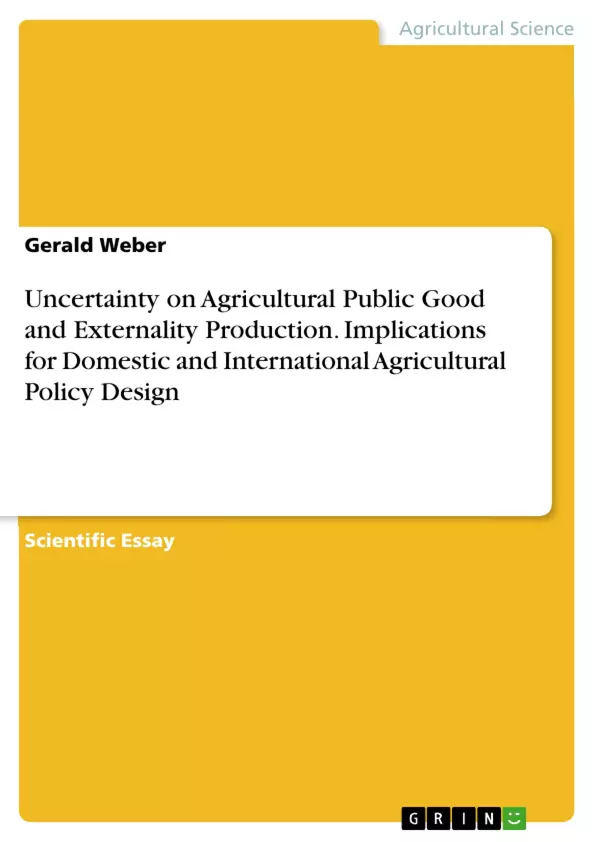This article deals with the consequences of uncertainties about the societal valuation of landscape benefits and environmental costs for multiple policy goal trade-offs that may result when internalising external benefits and costs by abolishing commodity subsidies, introducing land subsidies and intermediate input taxes. Numerical results of an illustrative model of the German agricultural sector are presented and trade-off curves for farm income, environmental cost reduction and landscape benefits are discussed. If the relevant criterion for policy decisions was a simple aggregation of the single policy goal indicators with constant weights, the optimality of policy options would be rather robust to valuation errors.
Expected exchange ratios between the different policy goals, however, can be severely distorted if policy-makers have wrong estimations of the true societal valuation of externalities. This may make targeted incentives that aim at a better orientation of agriculture towards societal demands appear too risky for policy-makers and finally leads to the blockage of policy changes. An appropriate policy portfolio should therefore comprise non-distorting compensations for negatively affected policy goals. The EU’s commitment in the WTO to multifunctional agriculture has to be underlined by effective domestic policy reforms, if this concept is not to be discredited as an attempt to justify disguised protectionism.
Inhaltsverzeichnis (Table of Contents)
- Summary
- Zusammenfassung
- Introduction
- Methodological approach
- The base version of MULTSIM - a reference for analysing uncertainty
- Valuation of externalities
- Policy scenarios
- Policy goal trade-offs
- Implications of uncertain knowledge on the societal valuation of public goods and externalities
- Conclusions for policy design
- Sources
- Annex
Zielsetzung und Themenschwerpunkte (Objectives and Key Themes)
This article investigates the consequences of uncertainty surrounding the societal valuation of landscape benefits and environmental costs for policy decisions regarding multifunctional agriculture. The study examines the impact of internalizing external benefits and costs through policy measures like abolishing commodity subsidies, introducing land subsidies, and intermediate input taxes. The article utilizes a numerical model of the German agricultural sector to illustrate potential trade-offs between farm income, environmental cost reduction, and landscape benefits.
- Valuation of externalities and public goods
- Multifunctional agriculture and policy design
- Trade-offs between economic and environmental objectives
- Implications of uncertain knowledge for policy decisions
- The role of modeling tools in policy advice
Zusammenfassung der Kapitel (Chapter Summaries)
- Introduction: This chapter outlines the importance of integrating valuation research into policy-decision support models. It highlights the complexities of multifunctional agriculture, particularly the co-existence of positive and negative externalities and their uncertain valuation. The chapter stresses the need for a multidisciplinary approach and the explicit addressing of uncertainties in policy advice.
- Methodological Approach: This chapter discusses the methodology employed in the study, focusing on the German agricultural supply model MULTSIM. It describes the model's structure, including its representation of commodity and non-commodity outputs, production factors, and farm types. The chapter also emphasizes the importance of selecting a modeling approach that balances comprehensiveness with ease of use for policy analysis.
- The base version of MULTSIM - a reference for analysing uncertainty: This section outlines the base version of the MULTSIM model, including its key parameters and assumptions. It details the policy scenarios used in the study, including the abolishment of commodity subsidies and the internalization of environmental costs and landscape benefits. This chapter provides a foundation for understanding the model's application in subsequent analysis.
Schlüsselwörter (Keywords)
This article centers on the evaluation of public goods and externalities generated by agriculture, highlighting the significance of incorporating empirical research into policy models. Key terms include environmental costs, landscape benefits, multifunctional agriculture, valuation of non-marketable outputs, uncertainty, agricultural sector modelling, and policy advice. The analysis investigates the implications of uncertainties in societal valuation for policy decisions, focusing on the potential for skewed trade-offs between economic and environmental objectives. This exploration emphasizes the need for robust policy strategies that account for uncertainties and mitigate risks associated with policy changes.
- Citation du texte
- Gerald Weber (Auteur), 2003, Uncertainty on Agricultural Public Good and Externality Production. Implications for Domestic and International Agricultural Policy Design, Munich, GRIN Verlag, https://www.grin.com/document/985991



